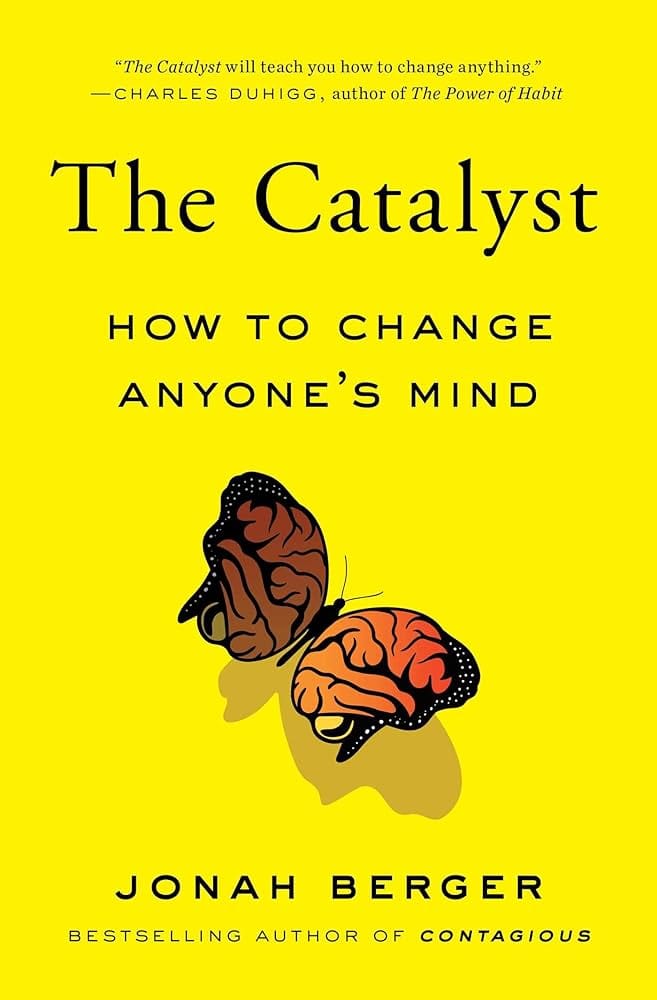- Non Fiction Fix
- Posts
- The Catalyst
The Catalyst
by Jonah Berger
Overview
"The Catalyst: How to Change Anyone's Mind" by Jonah Berger, published in 2020, explores the science of persuasion and the dynamics of change. As a professor of marketing at the Wharton School of Business, Berger draws on extensive research to present a framework for effectively influencing others and overcoming resistance to change.
Central Thesis
The central thesis of "The Catalyst" is that traditional methods of persuasion often fail because they rely on pushing harder or overwhelming people with information. Instead, Berger advocates for a "catalyst" approach that focuses on removing barriers to change, making it easier for individuals to shift their perspectives and behaviours.
Key Strengths
Research-Based Insights: The book is grounded in psychological research and behavioural science, providing a solid foundation for its claims.
Practical Framework: Berger outlines clear strategies for becoming an effective catalyst for change.
Engaging Examples: The author uses relatable anecdotes and case studies to illustrate his points.
Accessible Writing: The book is written in a conversational tone, making complex concepts easy to understand.
Structure of the Book
The book is structured around five key barriers to change, each addressed in its own chapter:
Reactance: The instinctive pushback people have when they feel their freedom is threatened.
Endowment: The tendency to overvalue what we already possess, making it hard to let go of the status quo.
Distance: The psychological and emotional distance that can inhibit change.
Uncertainty: The fear and hesitation that arise from not knowing the outcomes of a change.
Lack of Evidence: The need for credible proof to support new ideas or behaviours.
Key Concepts and Practical Insights
Reactance: To mitigate reactance, encourage self-persuasion by asking questions and fostering a sense of agency. Use empathetic listening to help others articulate their own reasons for change.
Endowment: To overcome the endowment effect, highlight the costs of inaction and reframe new ideas as extensions of what people already value. Use analogies to make new concepts feel familiar.
Distance: Reduce psychological distance by making ideas more relatable. Share stories and examples that resonate with the audience's experiences.
Uncertainty: Address uncertainty by providing clear information and examples that demonstrate the benefits of change. Use testimonials and case studies to build confidence in new ideas.
Evidence: Provide compelling evidence and social proof to support your arguments. Leverage data, testimonials, and peer influence to validate new concepts.
Memorable Quotes
"Change doesn’t happen by being more persuasive or pushing harder. It happens by removing the barriers to change."
"Sometimes change doesn’t require more horsepower. Sometimes we just need to unlock the parking brake."
"People are not like marbles. They won’t roll in the direction you push them."
Critique
While "The Catalyst" is praised for its insightful and practical approach, some critics argue that the book may oversimplify complex psychological dynamics. Additionally, readers looking for in-depth case studies may find the examples somewhat limited.
Target Audience
"The Catalyst" is valuable for marketers, business leaders, educators, and anyone interested in understanding how to influence others and facilitate change. Its practical insights make it suitable for a wide range of professionals.
Conclusion
"The Catalyst" offers a fresh perspective on the art of persuasion and change management. Jonah Berger's emphasis on removing barriers rather than pushing harder provides a valuable framework for anyone looking to influence others effectively. By combining research-based insights with practical strategies, the book serves as a useful guide for navigating the complexities of human behaviour and fostering meaningful change.
